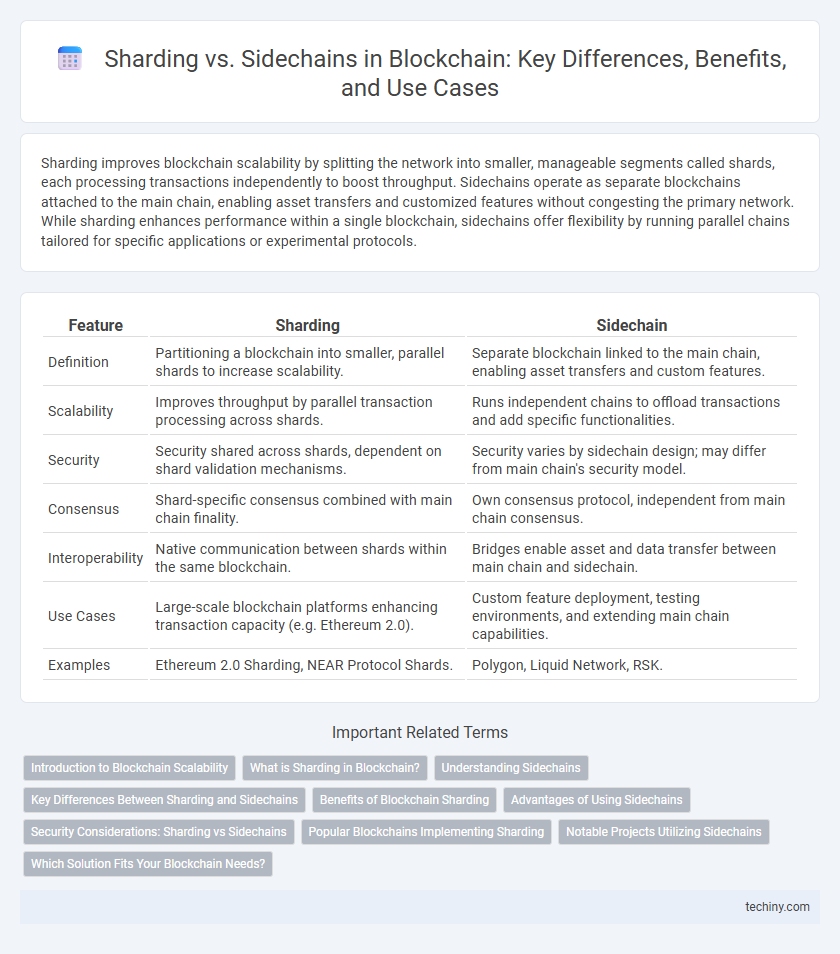Sharding improves blockchain scalability by splitting the network into smaller, manageable segments called shards, each processing transactions independently to boost throughput. Sidechains operate as separate blockchains attached to the main chain, enabling asset transfers and customized features without congesting the primary network. While sharding enhances performance within a single blockchain, sidechains offer flexibility by running parallel chains tailored for specific applications or experimental protocols.
Table of Comparison
| Feature | Sharding | Sidechain |
|---|---|---|
| Definition | Partitioning a blockchain into smaller, parallel shards to increase scalability. | Separate blockchain linked to the main chain, enabling asset transfers and custom features. |
| Scalability | Improves throughput by parallel transaction processing across shards. | Runs independent chains to offload transactions and add specific functionalities. |
| Security | Security shared across shards, dependent on shard validation mechanisms. | Security varies by sidechain design; may differ from main chain's security model. |
| Consensus | Shard-specific consensus combined with main chain finality. | Own consensus protocol, independent from main chain consensus. |
| Interoperability | Native communication between shards within the same blockchain. | Bridges enable asset and data transfer between main chain and sidechain. |
| Use Cases | Large-scale blockchain platforms enhancing transaction capacity (e.g. Ethereum 2.0). | Custom feature deployment, testing environments, and extending main chain capabilities. |
| Examples | Ethereum 2.0 Sharding, NEAR Protocol Shards. | Polygon, Liquid Network, RSK. |
Introduction to Blockchain Scalability
Blockchain scalability addresses the challenge of processing increasing transaction volumes without compromising decentralization or security. Sharding enhances scalability by partitioning the blockchain into smaller, parallel subsets called shards, each processing transactions independently to increase throughput. Sidechains operate as independent blockchains connected to the main chain, enabling offloading of transactions and smart contracts to reduce congestion while preserving interoperability.
What is Sharding in Blockchain?
Sharding in blockchain is a scalability solution that divides the entire network into smaller partitions called shards, allowing parallel transaction processing and data storage. Each shard operates independently with its own smart contracts and ledger, significantly increasing throughput and reducing latency. This method enhances decentralization while maintaining security by distributing the validation workload across multiple nodes.
Understanding Sidechains
Sidechains enable independent blockchains to operate alongside a main chain, allowing assets to be transferred between chains via a two-way peg mechanism. This approach enhances scalability by offloading transactions without compromising the security of the main chain. Unlike sharding, which partitions a single blockchain into multiple shards to process transactions in parallel, sidechains maintain distinct consensus rules and protocols, enabling specialized applications and customization.
Key Differences Between Sharding and Sidechains
Sharding divides a blockchain into smaller, parallel pieces called shards, each processing its own transactions to enhance scalability within a single network, while sidechains operate as independent blockchains linked to the main chain, enabling cross-chain asset transfers and specialized functionalities. Sharding relies on shared security from the main chain using consensus mechanisms across shards, whereas sidechains have their own consensus protocols and security models, which may vary significantly. Performance improvements in sharding come from parallel transaction processing, contrasting with sidechains that offer scalability by offloading specific tasks or applications outside the main blockchain.
Benefits of Blockchain Sharding
Blockchain sharding enhances scalability by partitioning the network into smaller, manageable segments called shards, allowing parallel transaction processing and significantly increasing throughput. This method reduces latency and boosts performance without compromising security, as each shard processes its transactions independently while maintaining consensus with the main chain. By enabling efficient use of resources and lowering the computational load on individual nodes, sharding supports higher transaction volumes and improved decentralization in blockchain networks.
Advantages of Using Sidechains
Sidechains enhance blockchain scalability by enabling assets to transfer between independent chains, reducing congestion on the main network. They facilitate customized consensus mechanisms tailored to specific use cases while maintaining interoperability with the main chain. This flexibility supports diverse applications, from decentralized finance (DeFi) to gaming, without compromising security or decentralization.
Security Considerations: Sharding vs Sidechains
Sharding enhances blockchain scalability by dividing the network into smaller partitions, but it introduces complex security risks such as cross-shard communication vulnerabilities and potential validator collusion. Sidechains operate as independent blockchains linked to the main chain, which can isolate security breaches but rely heavily on the robustness of the two-way peg mechanism and federation or cross-chain validators. Evaluating these approaches requires careful assessment of cross-chain trust assumptions, attack surfaces, and consensus integrity to ensure secure interoperability and data consistency.
Popular Blockchains Implementing Sharding
Ethereum 2.0, Polkadot, and Harmony are popular blockchains implementing sharding to improve scalability by dividing the main blockchain into smaller, manageable shards. Sharding allows parallel transaction processing, significantly increasing throughput and reducing network congestion compared to traditional sidechains, which operate independently with their own consensus mechanisms. By integrating sharding, these blockchains enhance decentralized applications' performance while maintaining security across multiple shards.
Notable Projects Utilizing Sidechains
Notable projects utilizing sidechains include Liquid Network by Blockstream, which enhances Bitcoin's scalability and transaction speed through a federated sidechain. Polygon, another prominent platform, leverages sidechains to facilitate faster and cheaper transactions for Ethereum-based decentralized applications. These implementations demonstrate sidechains' ability to offload processing from main chains while maintaining security via interoperability protocols.
Which Solution Fits Your Blockchain Needs?
Sharding enhances blockchain scalability by breaking the network into smaller partitions or shards, each processing transactions independently to improve throughput and reduce latency. Sidechains operate as separate blockchains linked to the main chain, allowing for custom features and offloading transactions while maintaining security through two-way peg mechanisms. Choosing between sharding and sidechains depends on factors like network complexity, desired scalability, transaction speed, and the need for customized functionalities or interoperability.
Sharding vs Sidechain Infographic

 techiny.com
techiny.com